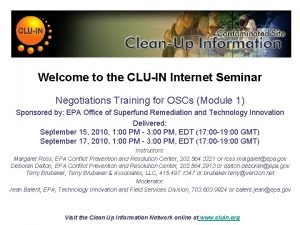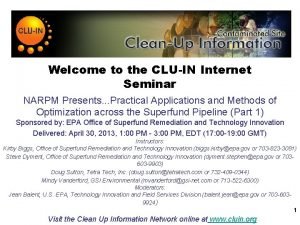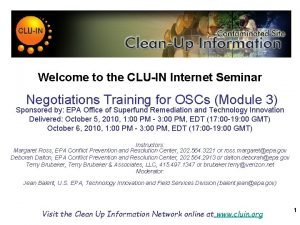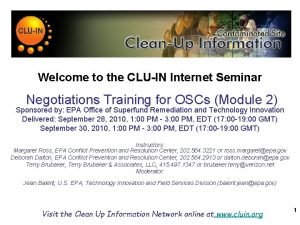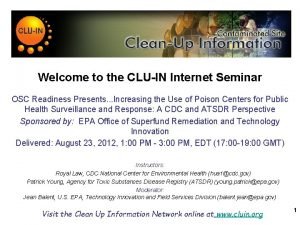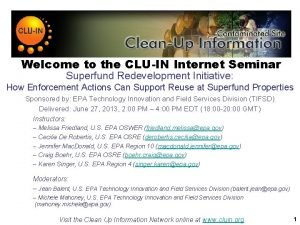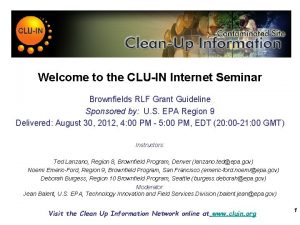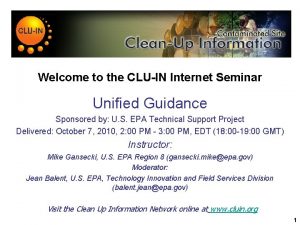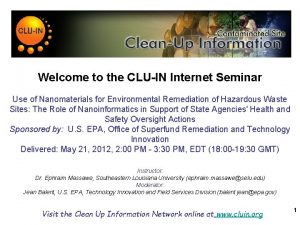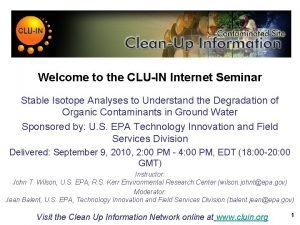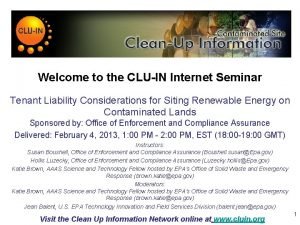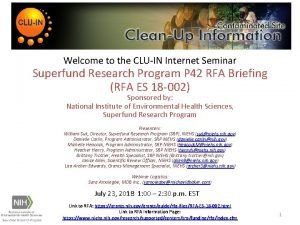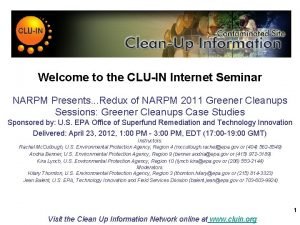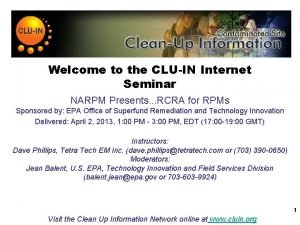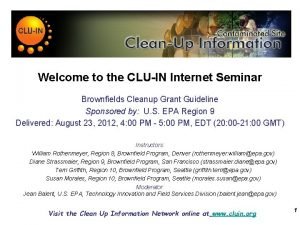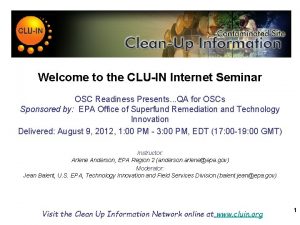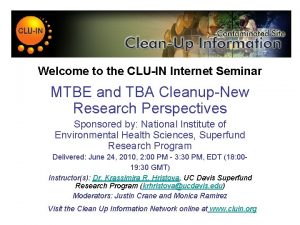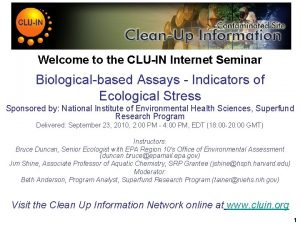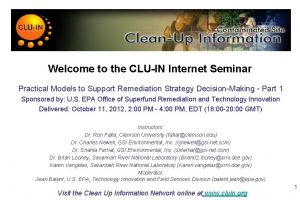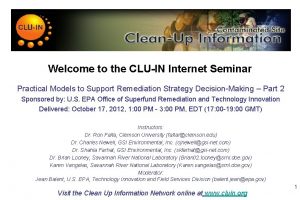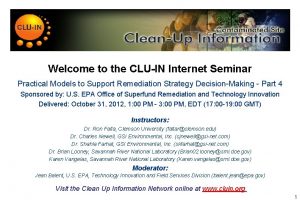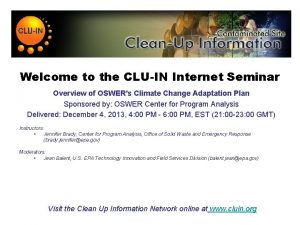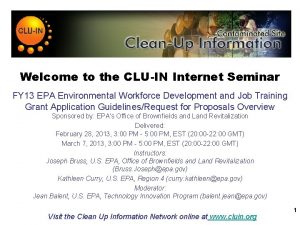Welcome to the CLUIN Internet Seminar Opportunities for





























![Log Kd [Mass on Filter/Volume Filtered] Kd= -----------------------[Mass on XAD/Volume Processed][TSS] 30 Log Kd [Mass on Filter/Volume Filtered] Kd= -----------------------[Mass on XAD/Volume Processed][TSS] 30](https://slidetodoc.com/presentation_image_h/0d378938e949c858508ad6cd0305c939/image-30.jpg)

































- Slides: 63

Welcome to the CLU-IN Internet Seminar “Opportunities for Bringing Rapidly Emerging Technologies to Revolutionize Modeling of Chemical Contaminants in Coastal Waters” Presenter: Dr. Joel Baker (jebaker@uw. edu) Moderator: Kira Lynch, US EPA Region 10 (Lynch. Kira@epamail. epa. gov) Agency Seminar Series at US EPA Region 10 Sponsored by University of Washington Superfund Research Program Delivered: October 4, 2012, 11: 00 AM-12: 30 PM, PDT Visit the Clean Up Information Network online at www. cluin. org 1

Housekeeping • • Please mute your phone lines, Do NOT put this call on hold Q&A Turn off any pop-up blockers Move through slides using # links on left or buttons Download slides as PPT or PDF Go to slide 1 Move back 1 slide Move forward 1 slide Go to last slide Go to seminar homepage Submit comment or question Report technical problems • This event is being recorded • Archives accessed for free http: //cluin. org/live/archive/ 2

Opportunities for Bringing Rapidly Emerging Technologies to Revolutionize Modeling of Chemical Contaminants of Coastal Waters Dr. Joel Baker Director, UW Puget Sound Institute University of Washington Tacoma 3

Introduction and Perspective May, 1982: Duluth, Minnesota 4

Introduction and Perspective October, 2012: Tacoma, WA 5

The Information Technology Revolution NJTech. Reviews 6

The Information Technology Revolution 2010 Map of the Global Internet by Cisco Systems 7

The Information Technology Revolution 8

Modeling Chemical Contaminants in Aquatic Ecosystems: Seminal Papers in PCB Modeling 9

Modeling Chemical Contaminants in Aquatic Ecosystems: Karickhoff et al. 1979 10

Modeling Chemical Contaminants in Aquatic Ecosystems: Karickhoff et al. 1979 11

Modeling Chemical Contaminants in Aquatic Ecosystems: Thomann and Di. Toro, 1983 12

Modeling Chemical Contaminants in Aquatic Ecosystems: Mackay, 1989 13

Modeling Chemical Contaminants in Aquatic Ecosystems: Mackay, 1989 14

Modeling Chemical Contaminants in Aquatic Ecosystems: Gobas and Mackay, 1988 15

Modeling Chemical Contaminants in Aquatic Ecosystems: Gobas and Mackay, 1988 16

Modeling Chemical Contaminants in Aquatic Ecosystems: Current Models R. A. Park et al. , 2010 17

Modeling Chemical Contaminants in Aquatic Ecosystems: NY/NJ Harbor CARP Model Management Question è Which sources of contaminants need to be reduced or eliminated to render future dredged material clean? 18

Modeling Chemical Contaminants in Aquatic Ecosystems: NY/NJ Harbor CARP Model 19

20

21

Summary of 2, 3, 7, 8 -TCDD interim “clean bed” analysis 22

The Information Technology Revolution ? CARP NJTech. Reviews 23

Premise of Today’s Talk Tools to model contaminant behavior and effects in aquatic ecosystems have not kept up with the information technology revolution 24

Corollaries 1. We assume that technology is frozen in time to what tools we had available in grad school (computers, IT, and analytical chemistry) 2. Innovation and experimentation may be seen at odds with stability and confidence 25

Wait! Is this really a problem? What are we missing with current models? 26

27

Non-Spherical Cows 1. Phase partitioning in the water column 28

• Use PCB and PAH distribution coefficients measured in the Chesapeake Bay to explore the mechanism driving observed variability – three-phase partitioning? – slow sorption kinetics? – highly sorbent particles? 29
![Log Kd Mass on FilterVolume Filtered Kd Mass on XADVolume ProcessedTSS 30 Log Kd [Mass on Filter/Volume Filtered] Kd= -----------------------[Mass on XAD/Volume Processed][TSS] 30](https://slidetodoc.com/presentation_image_h/0d378938e949c858508ad6cd0305c939/image-30.jpg)
Log Kd [Mass on Filter/Volume Filtered] Kd= -----------------------[Mass on XAD/Volume Processed][TSS] 30

Pyrene N = 119 Baltimore Harbor Surface Waters 31

32

Residual solid phase concentration (ng/g-dry) Investigating the sources of variability in partitioning 33

Investigating the sources of variability in partitioning 1. The presence of colloids KDOC = 0. 08 Kow High variation due to: the nature of DOC the methods used Environmental Science and Technology, 2000, 34, 4663 -4668 34

Investigating the sources of variability in partitioning DOC (mg/L) 1. The presence of colloids 70% between 3. 5 and 5. 5 mg/L 35

Investigating the sources of variability in partitioning 2. Kinetics of Partitioning Laboratory PCB congener sorption experiments • Gas-phase equilibration maintains constant dissolved PCB congener concentrations. • Stationary-phase chrysophyte Isochrysis galbana • 18 congeners studied over 120 hours 36

37 PCB Concentration in Algae

38

39 Observed Log KOC

Fraction dissolved pyrene Investigating the sources of variability in partitioning 3. Types of aquatic particles 40

41

1. Phase partitioning in the Water Column The observed variations in dissolved-particulate distributions of PCBs, PAHs, etc. are large and real. Although organic colloids likely moderate dissolved HOC concentrations, DOC does not vary enough to explain the observed partitioning. In studies with well-characterized solids, sorption kinetics are sufficiently fast (at least on a log-log plot). Remarkably large (i. e. , order of magnitude) variations in HOC-solid interactions among particle types. 42

Non-Spherical Cows 2. Interactions among particles 43

Physical characteristics of flocs • Lower settling velocity • Lower bulk density • Higher contact area (porosity) http: //www. water-technology. net/contractor_images/cu_water/flocke. jpg 44

How are flocs formed? Yao and O’Melia (1971) 45

Flocculation and PCB Models • The model simulated the floc size among 2 to 1000 µm • The multi-class flocculation model equations are based on the concept of O’Melia (1982) • The floc porosity and settling velocity are based on the concept of Winterwerp (1998) • The floc settling velocity, floc density, stickiness coefficient, and fraction of organic carbon (f. OC) are calculated simultaneously and temporally at each class of flocculation particle • The PCB mass transfer coefficient is varied with floc properties 46

Total Volume Concentration Particulate PCB Total Suspended Solids Dissolved PCB 47

Non-Spherical Cows 3. Chemical release during resuspension 48

Desorption Rates Engineering Performance Standards for Dredging Volume 2: Technical Basis and Implementation of the Resuspension Standard Given the length of time required for PCBs to reach equilibrium for desorption, it is unlikely that there will be large release of dissolved phase PCBs as a result of dredging activities. • Analysis assumes first order desorption kinetics during the first day of resuspension • Experiments show rapid (nearly instantaneous) release at onset of resuspension 49

Objectives • What is the initial release of PCBs from quiescent river sediment when it is resuspended (i. e. during high flow or dredging)? • How does the frequency and duration of resuspension events affect PCB desorption? 50

PCB Release from Sediment • Particulate-bound • Tracks sediment movement • Reduced bioavailability(? ) • Engineering controls: solids management • Dissolved • Tracks water movement • Directly bioavailable • Engineering controls: readsorption (? ) 51

Release of Dissolved PCBs from Sediment • Diffusion • Bioturbation • Resuspension • Amount of sediment resuspended • Residence time of the particles in the water column • Desorption rate 52

Methods: STORM Tanks • The 1000 L tanks produce high levels of bottom shear stress without generating excessive water column turbulence 53

Dissolved PCB 49 54

Release of Resuspended PCBs into the Dissolved Phase • After 1 hour of resuspension – First Resuspension: 20% – Second and Third Resuspensions: 15% • After 6 hours of resuspension – First Resuspension: 40% – Second and Third Resuspensions: 25% 55

Observations After only one hour, resuspension of 7. 4 mg/kg t-PCB Hudson River sediment under gentle conditions yields: • – – – 34 mg/L suspended solids 75 ng/L dissolved t-PCB 300 ng/L particulate t-PCB • 20% of the PCB mass resuspended is desorbed into the truly dissolved phase in one hour • Higher levels of suspended solids and higher t-PCB levels in sediments will result in larger dissolved concentrations 56

Observations • A fine fraction of the sediment enriched in t-PCBs is readily resuspended and does not resettle over 12 hours. This material will likely be transported downstream. • Both desorption kinetics and observed PCB behavior during resettling are consistent with PCB release being dominated by fine-grain particles. 57

Lessons Learned (so far…) 1. “Don’t make me come out of retirement to come back here to fix the loadings estimates” – R. Thomann 2. “Sediment transport is a side show” – D. Di. Toro Keep your eye on the ball 3. “If a simulation won’t finish overnight the model is too complex” The modeling effort must generate something that fits on a manager’s laptop 4. Complex systems require continual review during development Building inspectors 58

Final Thoughts Complex models are too expensive to develop and run too slowly to be useful Moore’s Law and Silicon Qubits You can’t calibrate a highly resolved model Self-learning using real-time observations? Sediment transport is too hard to model In situ PSD measurements and highly resolved hydrodynamics Nobody understand complex models Pixar studios 59

Dr. Joel Baker Director, UW Puget Sound Institute University of Washington Tacoma jebaker@uw. edu 60

Links page • Dr. Joel Baker (jebaker@uw. edu) • Center for Urban Water at University of Washington Tacoma: http: //www. tacoma. uw. edu/center-urban-waters • University of Washington Superfund Research Program: http: //depts. washington. edu/sfund/ • US EPA Region 10: http: //www. epa. gov/aboutepa/region 10. html • National Institute of Environmental Health Institute (NIEHS)Superfund Research Program http: //www. niehs. nih. gov/research/supported/srp/ 61

Thank you for your time! Please click here to give the UW-SRP your feedback! Need confirmation of your participation today? Fill out the CLU-IN feedback form and check box for confirmation email. If you have additional questions or comments, please contact: Katie Frevert, University of Washington Superfund Research Program (UW-SRP) kfrevert@u. washington. edu Tel (206)685 -5379 62

New Ways to stay connected! • Follow CLU-IN on Facebook, Linked. In, or Twitter https: //www. facebook. com/EPAClean. Up. Tech https: //twitter. com/#!/EPAClean. Up. Tech http: //www. linkedin. com/groups/Clean-Up. Information-Network-CLUIN-4405740 63
 Welcome welcome this is our christmas story
Welcome welcome this is our christmas story Internet or internet
Internet or internet Datorkunskap för nybörjare
Datorkunskap för nybörjare Tack för att ni har lyssnat
Tack för att ni har lyssnat Returpilarna
Returpilarna Läkarutlåtande för livränta
Läkarutlåtande för livränta Klassificeringsstruktur för kommunala verksamheter
Klassificeringsstruktur för kommunala verksamheter Tack för att ni lyssnade
Tack för att ni lyssnade Påbyggnader för flakfordon
Påbyggnader för flakfordon Egg för emanuel
Egg för emanuel Atmosfr
Atmosfr Biologiska arvet
Biologiska arvet Lågenergihus nyproduktion
Lågenergihus nyproduktion Vilotidsbok
Vilotidsbok Rutin för avvikelsehantering
Rutin för avvikelsehantering Myndigheten för delaktighet
Myndigheten för delaktighet Presentera för publik crossboss
Presentera för publik crossboss Rådet för byggkompetens
Rådet för byggkompetens Kontinuitetshantering i praktiken
Kontinuitetshantering i praktiken Kung som dog 1611
Kung som dog 1611 Tack för att ni har lyssnat
Tack för att ni har lyssnat Tobinskatten för och nackdelar
Tobinskatten för och nackdelar Boverket ka
Boverket ka Hur ser ett referat ut
Hur ser ett referat ut Varför kallas perioden 1918-1939 för mellankrigstiden
Varför kallas perioden 1918-1939 för mellankrigstiden Karttecken tät skog
Karttecken tät skog Mjälthilus
Mjälthilus Uppställning multiplikation
Uppställning multiplikation Formel för lufttryck
Formel för lufttryck Elektronik för barn
Elektronik för barn Borra hål för knoppar
Borra hål för knoppar Bris för vuxna
Bris för vuxna Mat för unga idrottare
Mat för unga idrottare A gastrica
A gastrica Smärtskolan kunskap för livet
Smärtskolan kunskap för livet Trög för kemist
Trög för kemist Argument för teckenspråk som minoritetsspråk
Argument för teckenspråk som minoritetsspråk Novell typiska drag
Novell typiska drag Delegerande ledarskap
Delegerande ledarskap Humanitr
Humanitr Rita perspektiv
Rita perspektiv Toppslätskivling dos
Toppslätskivling dos Debatt mall
Debatt mall Redogör för vad psykologi är
Redogör för vad psykologi är Claes martinsson
Claes martinsson En lathund för arbete med kontinuitetshantering
En lathund för arbete med kontinuitetshantering Ramsa geometriska former
Ramsa geometriska former Offentlig förvaltning
Offentlig förvaltning Exempel på lyrik
Exempel på lyrik Etik och ledarskap etisk kod för chefer
Etik och ledarskap etisk kod för chefer Antikt plagg
Antikt plagg Orubbliga rättigheter
Orubbliga rättigheter Ministerstyre för och nackdelar
Ministerstyre för och nackdelar Bamse för de yngsta
Bamse för de yngsta Förklara densitet för barn
Förklara densitet för barn Sju principer för tillitsbaserad styrning
Sju principer för tillitsbaserad styrning Bat mitza
Bat mitza Nationell inriktning för artificiell intelligens
Nationell inriktning för artificiell intelligens Nyckelkompetenser för livslångt lärande
Nyckelkompetenser för livslångt lärande Ro i rom pax
Ro i rom pax Handledning reflektionsmodellen
Handledning reflektionsmodellen Ledningssystem för verksamhetsinformation
Ledningssystem för verksamhetsinformation Stål för stötfångarsystem
Stål för stötfångarsystem Centrum för kunskap och säkerhet
Centrum för kunskap och säkerhet
































































